Abstract
Serum levels of immunoreactive insulinlike growth factors (IGF) I and II were determined by a modified IGF I and a new IGF II radioimmunoassay in normal children and adults, and in patients with acromegaly, isolated growth hormone deficiency, and extrapancreatic tumor hypoglycemia. Serum samples were gel filtered by a simple routine procedure at acidic pH to dissociate and separate IGF from the IGF carrier protein. Mean immunoreactive IGF I levels (+/- SD; corrected for crossreactivity of IGF II) were 193 +/- 58 ng/ml in normal adult subjects, 712 +/- 245 ng/ml in acromegalic patients and 24 +/- 14 ng/ml in patients with isolated growth hormone deficiency. The lack of growth hormone alone, irrespective of an otherwise normal hormonal status, appears to be responsible for the drastic decrease of IGF I levels. Oversecretion of growth hormone does not increase the levels of immunoreactive IGF II: mean levels (+/- SD; corrected for crossreactivity of IGF I) in normal and acromegalic subjects are virtually identical (647 +/- 126 and 641 +/- 189 ng/ml, respectively). Apparently, normal growth hormone levels stimulate IGF II production already maximally. However in growth hormone deficiency immunoreactive IGF II is significantly decreased (252 +/- 99 ng/ml). Thus, IGF II, like IGF I, is growth hormone dependent. But in contrast to IGF I, the growth hormone dependence of IGF II seems to become apparent only at subnormal growth hormone levels. In normal children IGF I is age dependent: it is low in newborn cord sera (51 +/- 20 ng/ml) and gradually rises into the adult range with increasing age. At the onset of and during puberty mean IGF I levels lie above prepubertal values. In contrast, IGF II levels in normal children are independent of age and pubertal stage beyond the first year of life, whereas newborns have significantly lower IGF II values. Hypoglycemia resulting from extrapancreatic tumors is not associated with increased immunoreactive IGF I or II levels. IGF I is decreased in most of the sera (mean level +/- SD:56 +/- 39 ng/ml) whereas IGF II lies in the normal range (556 +/- 195 ng/ml).
Full text
PDF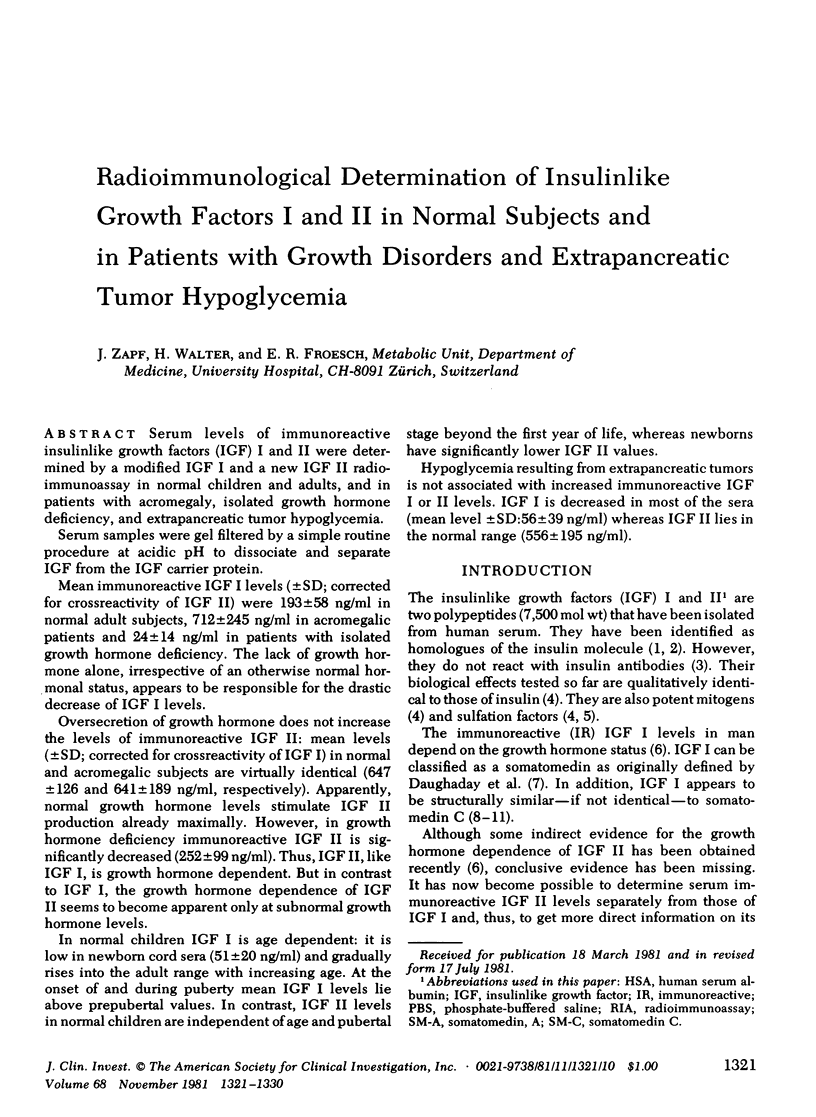
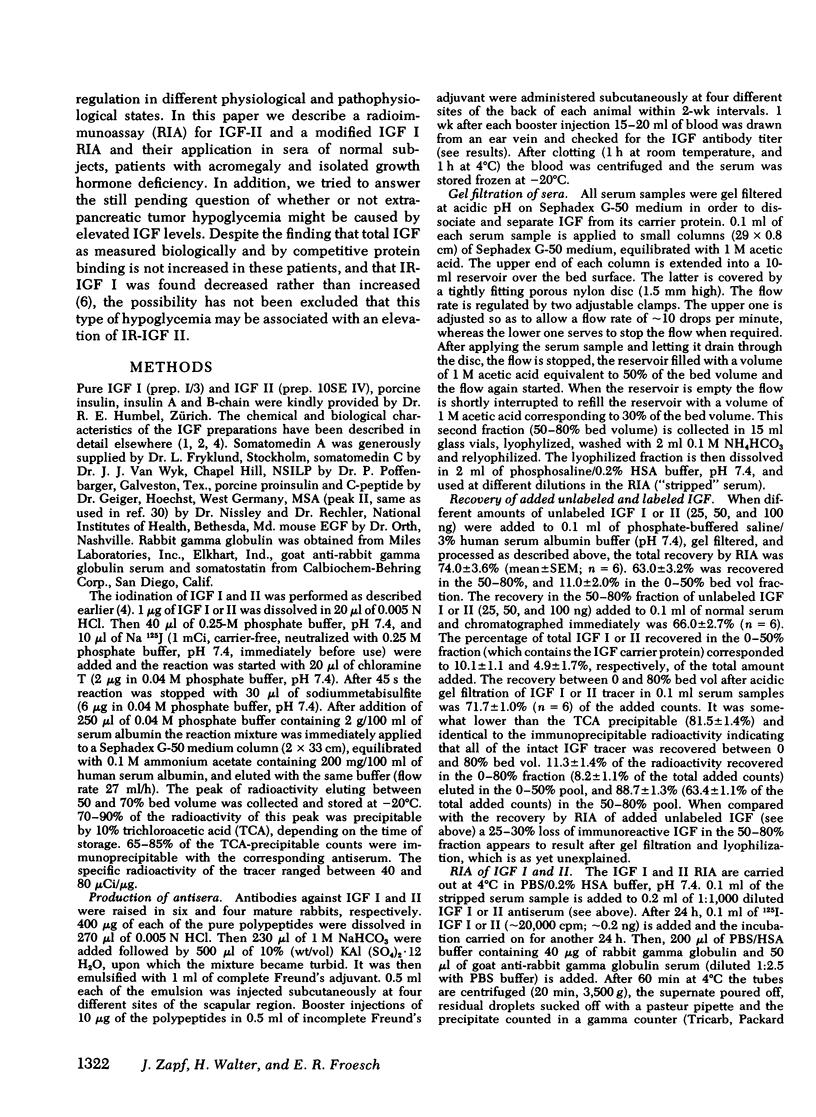
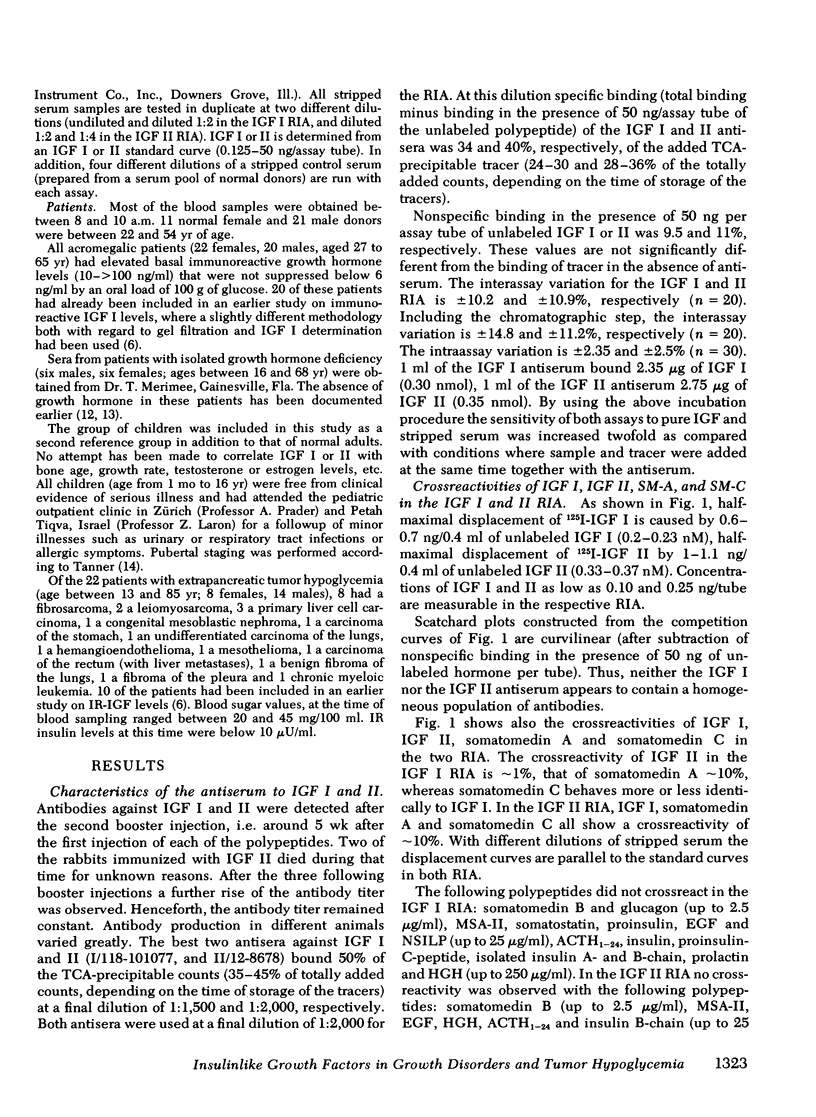
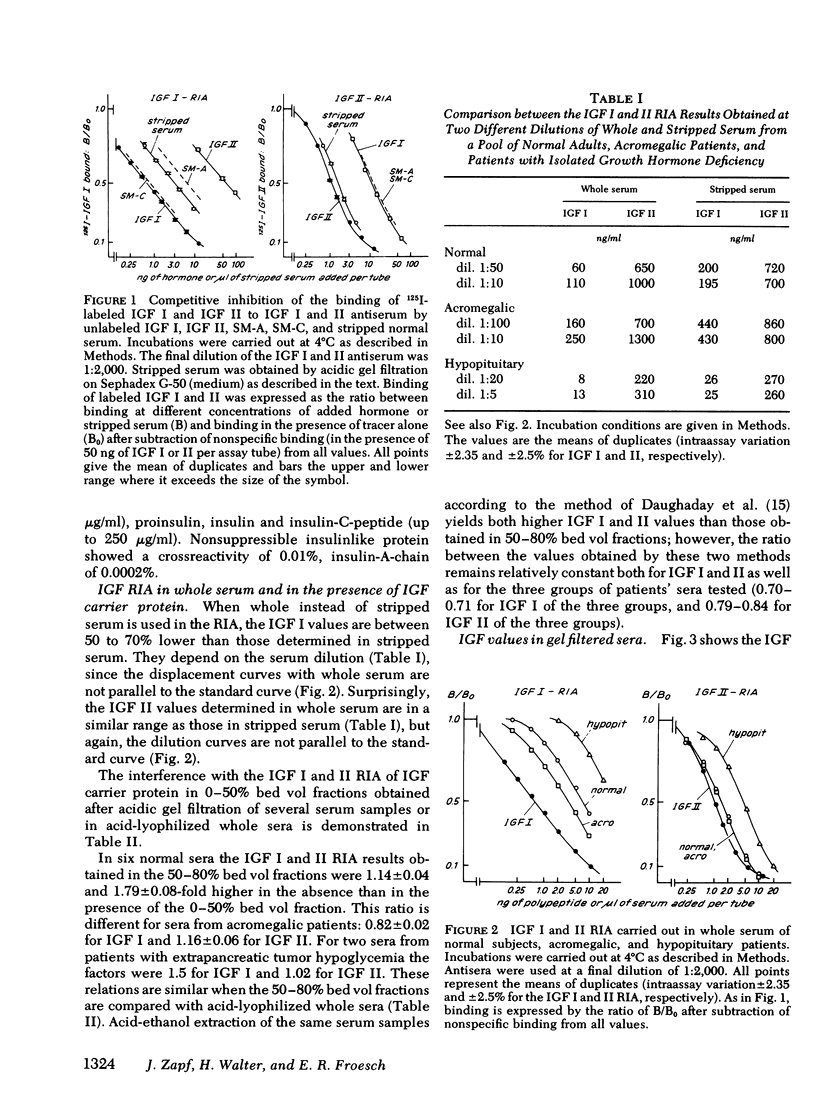
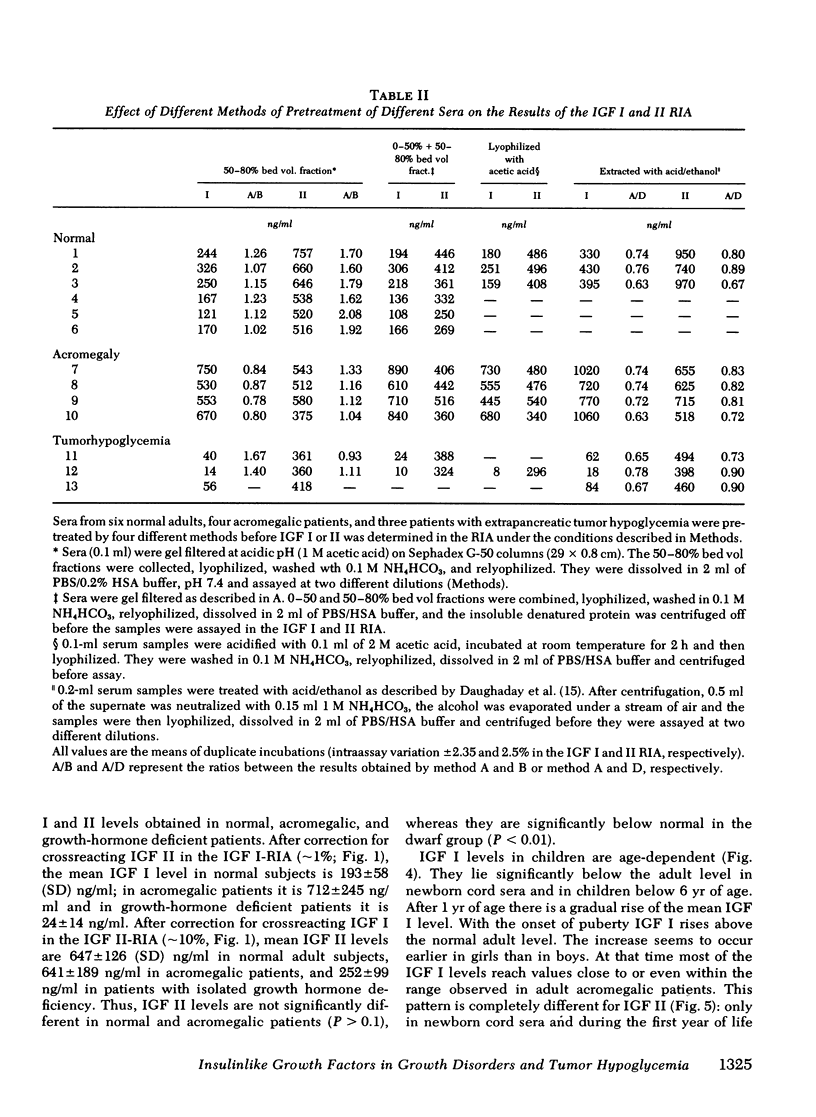
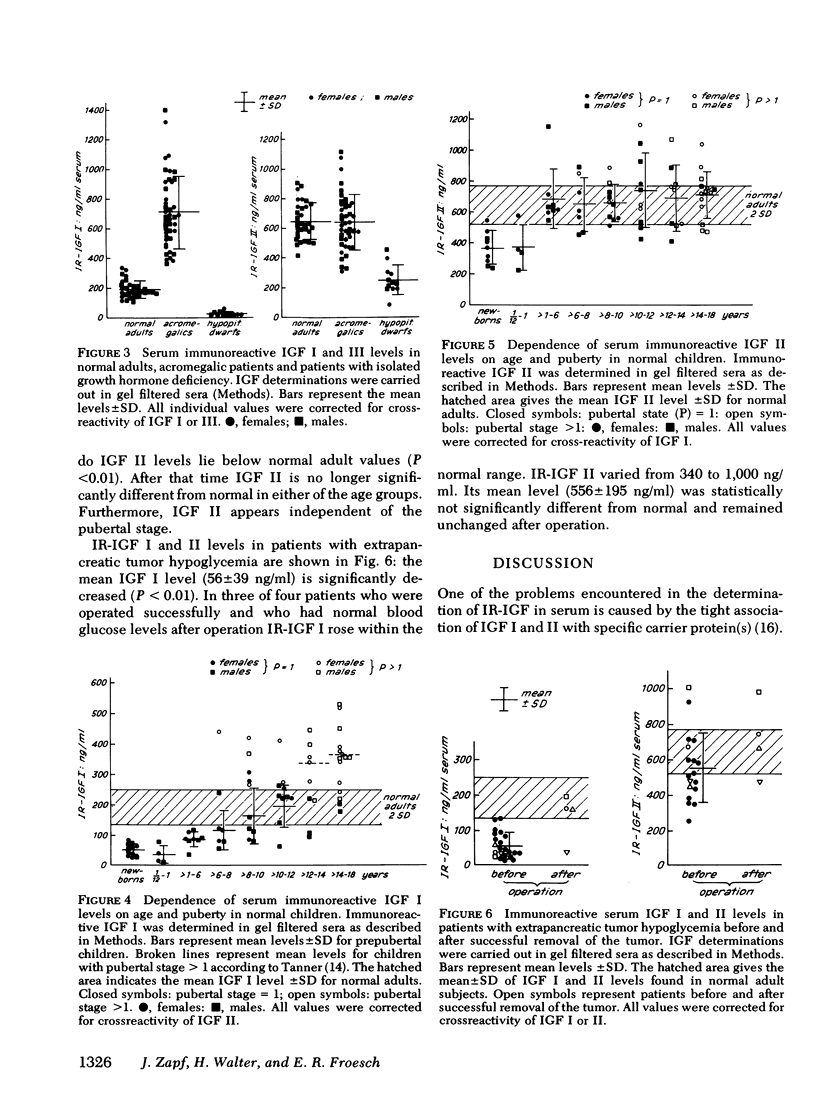
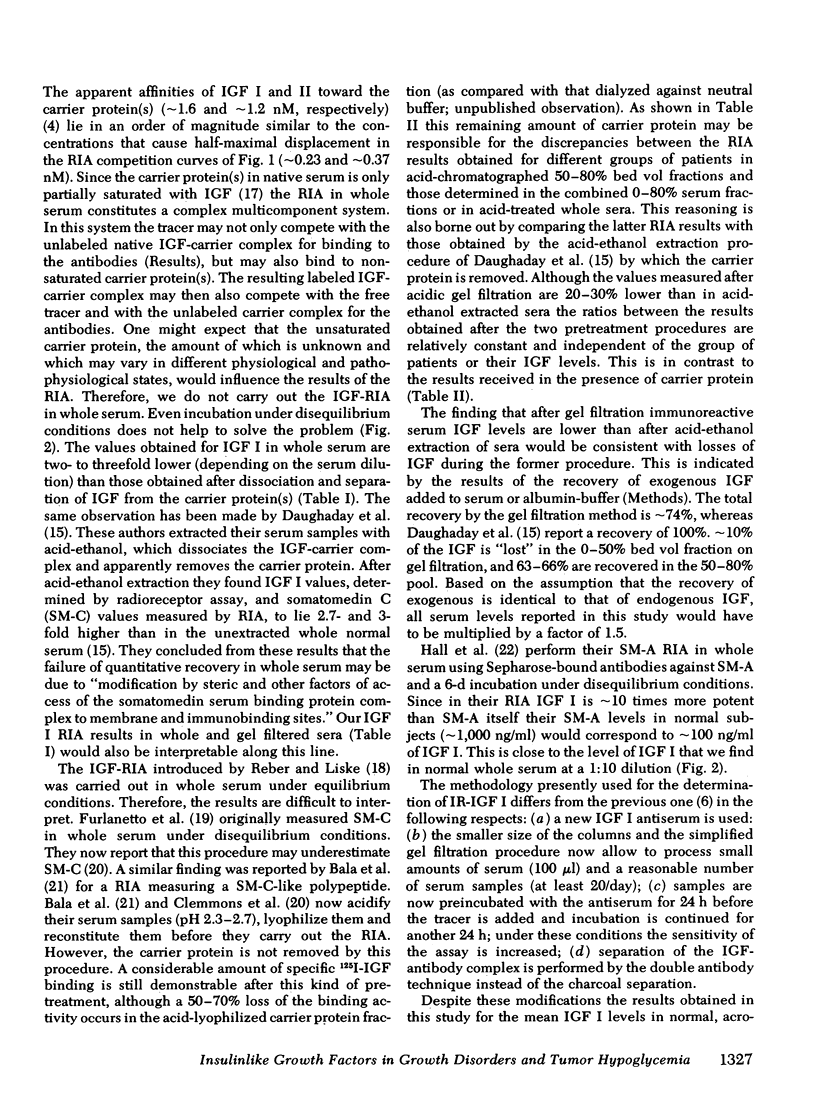
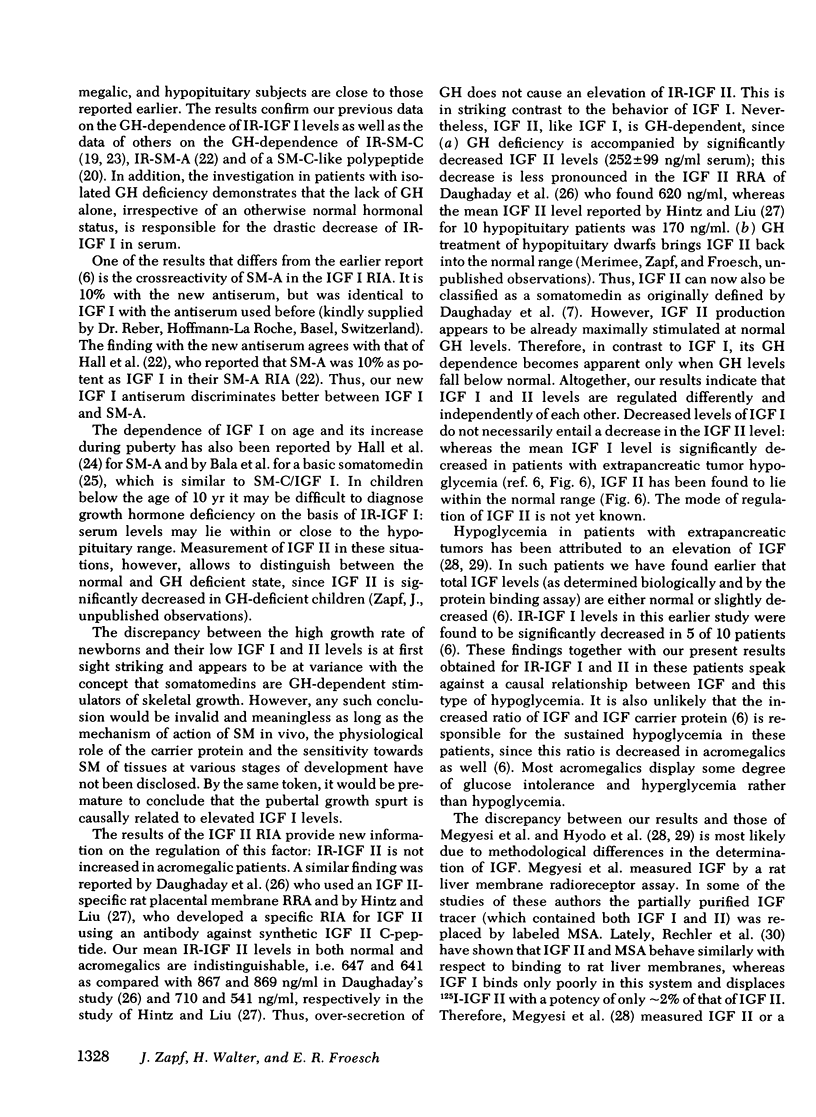
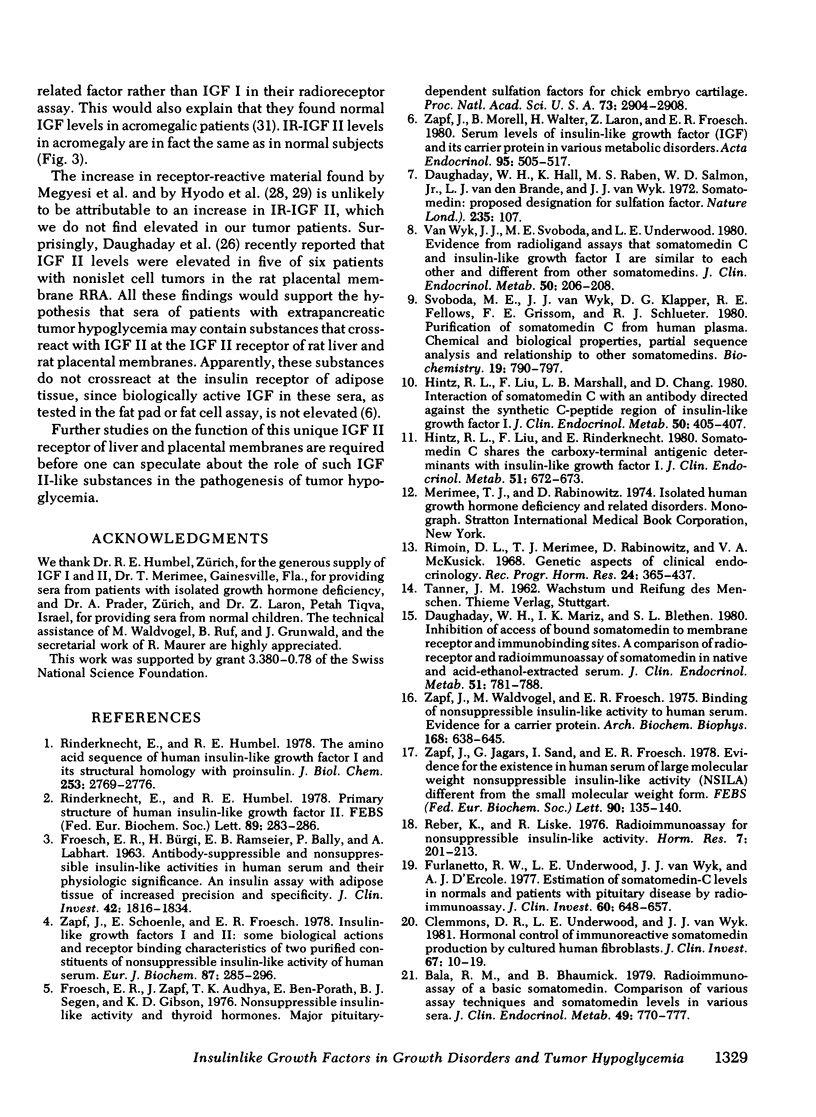
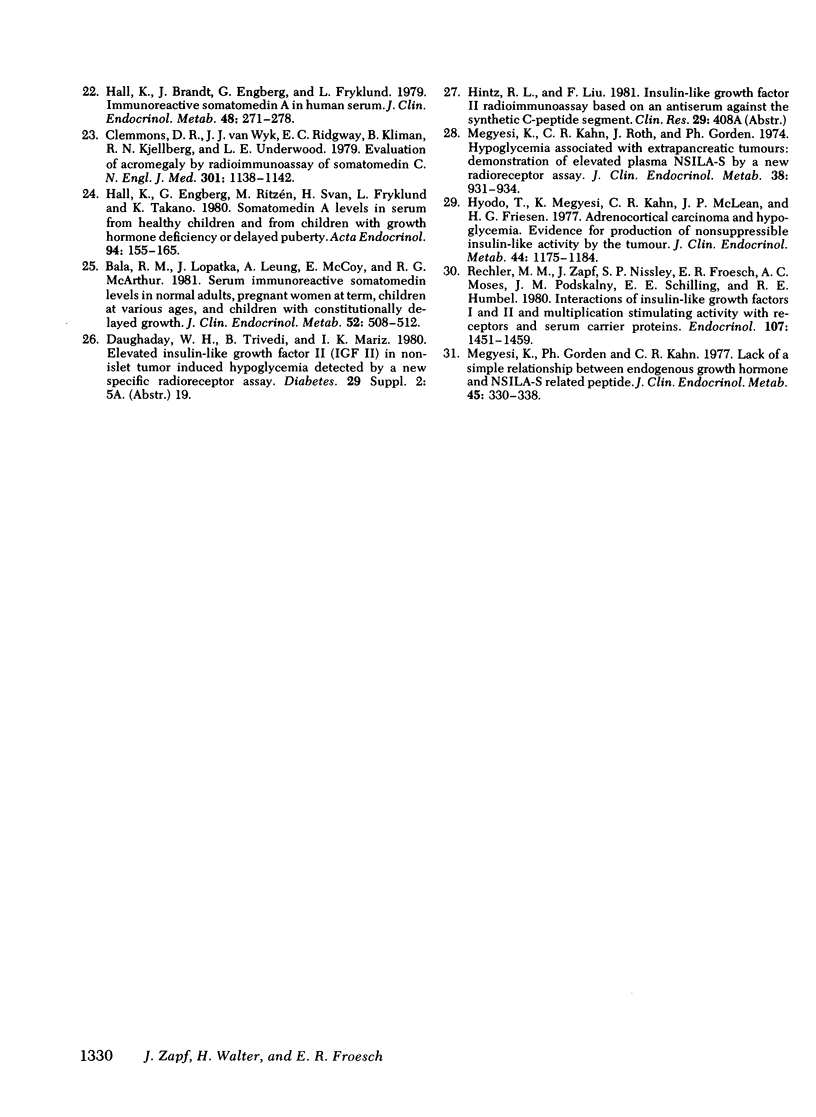
Selected References
These references are in PubMed. This may not be the complete list of references from this article.
- Bala R. M., Bhaumick B. Radioimmunoassay of a basic somatomedin: comparison of various assay techniques and somatomedin levels in various sera. J Clin Endocrinol Metab. 1979 Nov;49(5):770–777. doi: 10.1210/jcem-49-5-770. [DOI] [PubMed] [Google Scholar]
- Bala R. M., Lopatka J., Leung A., McCoy E., McArthur R. G. Serum immunoreactive somatomedin levels in normal adults, pregnant women at term, children at various ages, and children with constitutionally delayed growth. J Clin Endocrinol Metab. 1981 Mar;52(3):508–512. doi: 10.1210/jcem-52-3-508. [DOI] [PubMed] [Google Scholar]
- Clemmons D. R., Underwood L. E., Van Wyk J. J. Hormonal control of immunoreactive somatomedin production by cultured human fibroblasts. J Clin Invest. 1981 Jan;67(1):10–19. doi: 10.1172/JCI110001. [DOI] [PMC free article] [PubMed] [Google Scholar]
- Clemmons D. R., Van Wyk J. J., Ridgway E. C., Kliman B., Kjellberg R. N., Underwood L. E. Evaluation of acromegaly by radioimmunoassay of somatomedin-C. N Engl J Med. 1979 Nov 22;301(21):1138–1142. doi: 10.1056/NEJM197911223012102. [DOI] [PubMed] [Google Scholar]
- Daughaday W. H., Hall K., Raben M. S., Salmon W. D., Jr, van den Brande J. L., van Wyk J. J. Somatomedin: proposed designation for sulphation factor. Nature. 1972 Jan 14;235(5333):107–107. doi: 10.1038/235107a0. [DOI] [PubMed] [Google Scholar]
- Daughaday W. H., Mariz I. K., Blethen S. L. Inhibition of access of bound somatomedin to membrane receptor and immunobinding sites: a comparison of radioreceptor and radioimmunoassay of somatomedin in native and acid-ethanol-extracted serum. J Clin Endocrinol Metab. 1980 Oct;51(4):781–788. doi: 10.1210/jcem-51-4-781. [DOI] [PubMed] [Google Scholar]
- FROESCH E. R., BUERGI H., RAMSEIER E. B., BALLY P., LABHART A. ANTIBODY-SUPPRESSIBLE AND NONSUPPRESSIBLE INSULIN-LIKE ACTIVITIES IN HUMAN SERUM AND THEIR PHYSIOLOGIC SIGNIFICANCE. AN INSULIN ASSAY WITH ADIPOSE TISSUE OF INCREASED PRECISION AND SPECIFICITY. J Clin Invest. 1963 Nov;42:1816–1834. doi: 10.1172/JCI104866. [DOI] [PMC free article] [PubMed] [Google Scholar]
- Froesch E. R., Zapf J., Audhya T. K., Ben-Porath E., Segen B. J., Gibson K. D. Nonsuppressible insulin-like activity and thyroid hormones: major pituitary-dependent sulfation factors for chick embryo cartilage. Proc Natl Acad Sci U S A. 1976 Aug;73(8):2904–2908. doi: 10.1073/pnas.73.8.2904. [DOI] [PMC free article] [PubMed] [Google Scholar]
- Furlanetto R. W., Underwood L. E., Van Wyk J. J., D'Ercole A. J. Estimation of somatomedin-C levels in normals and patients with pituitary disease by radioimmunoassay. J Clin Invest. 1977 Sep;60(3):648–657. doi: 10.1172/JCI108816. [DOI] [PMC free article] [PubMed] [Google Scholar]
- Hall K., Brandt J., Enberg G., Fryklund L. Immunoreactive somatomedin A in human serum. J Clin Endocrinol Metab. 1979 Feb;48(2):271–278. doi: 10.1210/jcem-48-2-271. [DOI] [PubMed] [Google Scholar]
- Hall K., Enberg G., Ritzén M., Svan H., Fryklund L., Takano K. Somatomedin A levels in serum from healthy children and from children with growth hormone deficiency or delayed puberty. Acta Endocrinol (Copenh) 1980 Jun;94(2):155–165. doi: 10.1530/acta.0.0940155. [DOI] [PubMed] [Google Scholar]
- Hintz R. L., Liu F., Marshall L. B., Chang D. Interaction of somatomedin-C with an antibody directed against the synthetic C-peptide region of insulin-like growth factor-I. J Clin Endocrinol Metab. 1980 Feb;50(2):405–407. doi: 10.1210/jcem-50-2-405. [DOI] [PubMed] [Google Scholar]
- Hintz R. L., Rinderknecht E. Somatomedin-C shares the carboxy-terminal antigenic determinants with insulin-like growth factor-I. J Clin Endocrinol Metab. 1980 Sep;51(3):672–673. doi: 10.1210/jcem-51-3-672. [DOI] [PubMed] [Google Scholar]
- Hyodo T., Megyesi K., Kahn C. R., McLean J. P., Friesen H. G. Adrenocortical carcinoma and hypoglycemia: evidence for production of nonsuppressible insulin-like activity by the tumor. J Clin Endocrinol Metab. 1977 Jun;44(6):1175–1184. doi: 10.1210/jcem-44-6-1175. [DOI] [PubMed] [Google Scholar]
- Megyesi K., Gorden P., Kahn R. Lack of a simple relationship between endogenous growth hormone and NSILA-s related peptides. J Clin Endocrinol Metab. 1977 Aug;45(2):330–338. doi: 10.1210/jcem-45-2-330. [DOI] [PubMed] [Google Scholar]
- Megyesi K., Kahn C. R., Roth J., Gorden P. Hypoglycemia in association with extrapancreatic tumors: demonstration of elevated plasma NSILA-s by a new radioreceptor assay. J Clin Endocrinol Metab. 1974 May;38(5):931–934. doi: 10.1210/jcem-38-5-931. [DOI] [PubMed] [Google Scholar]
- Reber K., Liske R. Radioimmunoassay for non-suppressible insulin-like activity. Horm Res. 1976;7(4-5):201–213. doi: 10.1159/000178730. [DOI] [PubMed] [Google Scholar]
- Rechler M. M., Zapf J., Nissley S. P., Froesch E. R., Moses A. C., Podskalny J. M., Schilling E. E., Humbel R. E. Interactions of insulin-like growth factors I and II and multiplication-stimulating activity with receptors and serum carrier proteins. Endocrinology. 1980 Nov;107(5):1451–1459. doi: 10.1210/endo-107-5-1451. [DOI] [PubMed] [Google Scholar]
- Rimoin D. L., Merimee T. J., Rabinowitz D., McKusick V. A. Genetic aspects of clinical endocrinology. Recent Prog Horm Res. 1968;24:365–437. doi: 10.1016/b978-1-4831-9827-9.50014-9. [DOI] [PubMed] [Google Scholar]
- Rinderknecht E., Humbel R. E. Primary structure of human insulin-like growth factor II. FEBS Lett. 1978 May 15;89(2):283–286. doi: 10.1016/0014-5793(78)80237-3. [DOI] [PubMed] [Google Scholar]
- Rinderknecht E., Humbel R. E. The amino acid sequence of human insulin-like growth factor I and its structural homology with proinsulin. J Biol Chem. 1978 Apr 25;253(8):2769–2776. [PubMed] [Google Scholar]
- Svoboda M. E., Van Wyk J. J., Klapper D. G., Fellows R. E., Grissom F. E., Schlueter R. J. Purification of somatomedin-C from human plasma: chemical and biological properties, partial sequence analysis, and relationship to other somatomedins. Biochemistry. 1980 Feb 19;19(4):790–797. doi: 10.1021/bi00545a027. [DOI] [PubMed] [Google Scholar]
- Van Wyk J. J., Svoboda M. E., Underwood L. E. Evidence from radioligand assays that somatomedin-C and insulin-like growth factor-I are similar to each other and different from other somatomedins. J Clin Endocrinol Metab. 1980 Jan;50(1):206–208. doi: 10.1210/jcem-50-1-206. [DOI] [PubMed] [Google Scholar]
- Zapf J., Jagars G., Sand I., Froesch E. R. Evidence for the existence in human serum of large molecular weight nonsuppressible insulin-like activity (NSILA) different from the small molecular weight forms. FEBS Lett. 1978 Jun 1;90(1):135–140. doi: 10.1016/0014-5793(78)80315-9. [DOI] [PubMed] [Google Scholar]
- Zapf J., Morell B., Walter H., Laron Z., Froesch E. R. Serum levels of insulin-like growth factor (IGF) and its carrier protein in various metabolic disorders. Acta Endocrinol (Copenh) 1980 Dec;95(4):505–517. doi: 10.1530/acta.0.0950505. [DOI] [PubMed] [Google Scholar]
- Zapf J., Schoenle E., Froesch E. R. Insulin-like growth factors I and II: some biological actions and receptor binding characteristics of two purified constituents of nonsuppressible insulin-like activity of human serum. Eur J Biochem. 1978 Jun 15;87(2):285–296. doi: 10.1111/j.1432-1033.1978.tb12377.x. [DOI] [PubMed] [Google Scholar]
- Zapf J., Waldvogel M., Froesch E. R. Binding of nonsuppressible insulinlike activity to human serum. Evidence for a carrier protein. Arch Biochem Biophys. 1975 Jun;168(2):638–645. doi: 10.1016/0003-9861(75)90296-9. [DOI] [PubMed] [Google Scholar]


